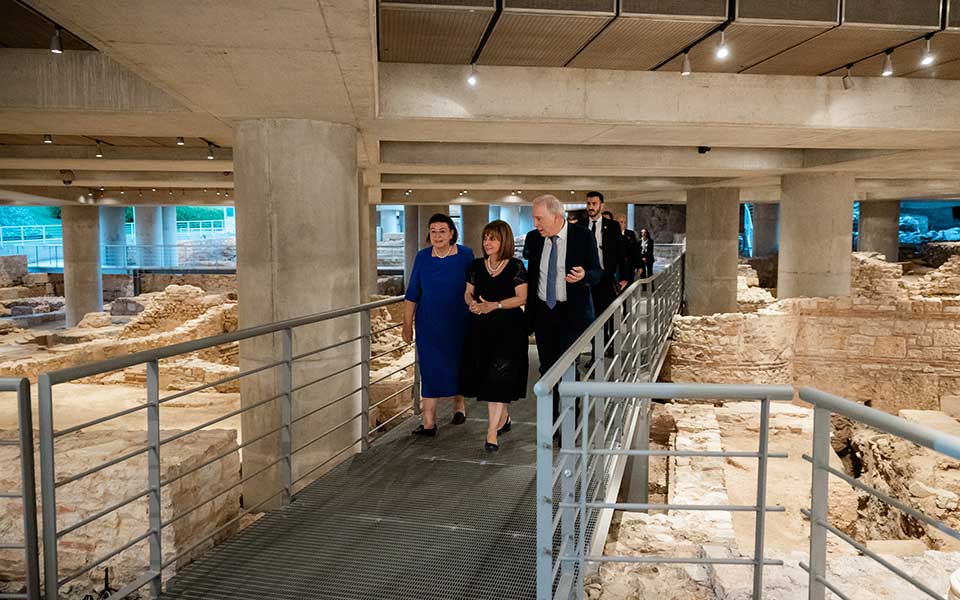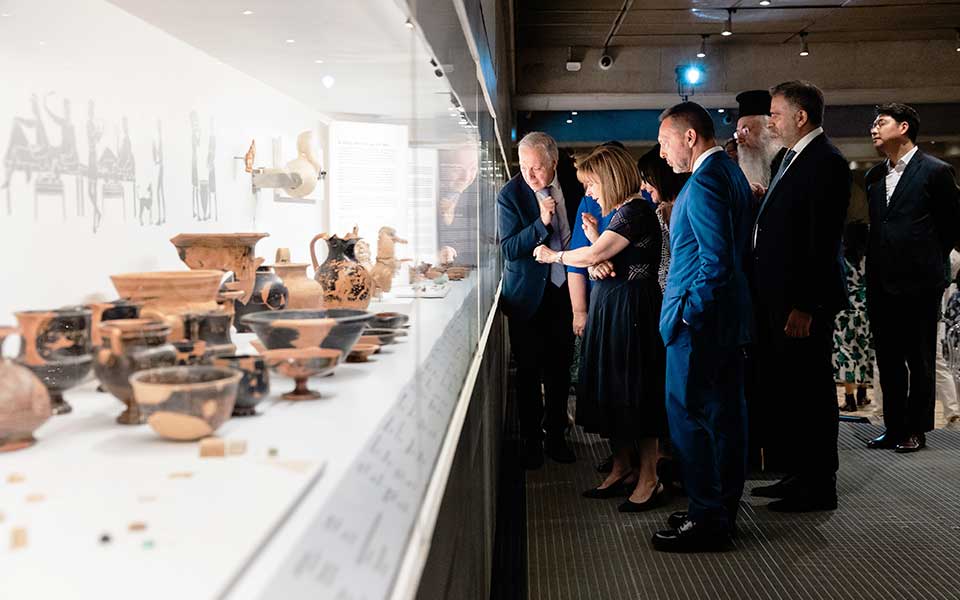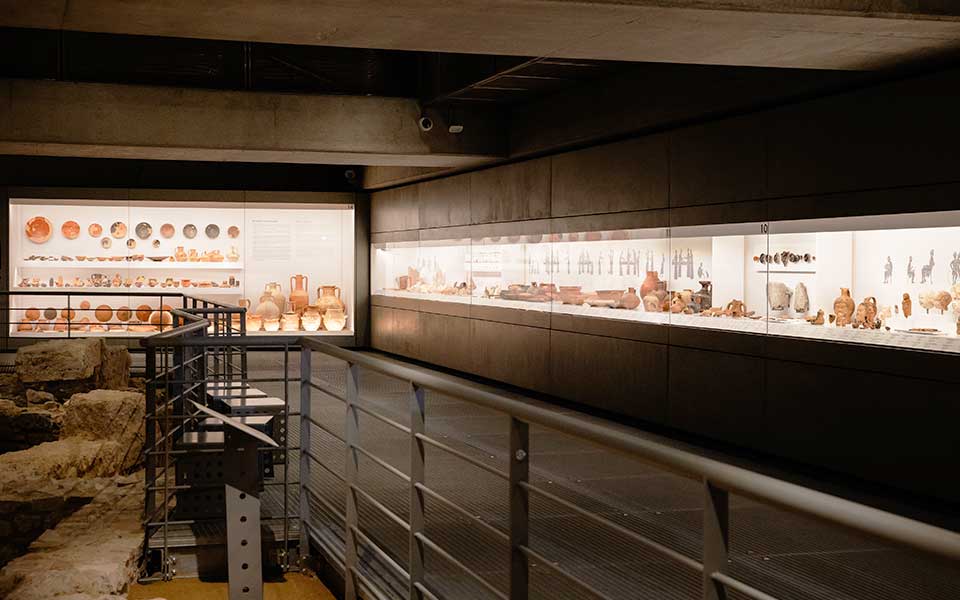Marking its 15th anniversary, a new chapter in the rich history of the award-winning Acropolis Museum began yesterday with the official opening of the “Excavation Museum,” inaugurated by the Greek President Katerina Sakellaropoulou. This innovative exhibition space, located on the southern edge of the museum’s excavation site, showcases 1,150 objects from the vast collection of artifacts unearthed from the ancient neighborhood beneath the museum, the famous Makrigianni Plot. These everyday items, from storage vessels and cooking pots to weaving tools and needles, offer a vivid glimpse into the daily lives of Athens’ ancient inhabitants, spanning over 4,500 years.
The “Excavation Museum” was made possible by the generous support of the Bank of Greece. Various media and communication sponsors, as well as Athens International Airport and STASY (Athens Urban Rail Network), also played a significant role in bringing this project to fruition.

© Studio Panoulis
A Journey Through Time
During the inauguration, Professor Nikolaos Chr. Stampolidis, General Director of the Acropolis Museum, highlighted the significance of the new exhibition. “The city is the sum of its citizens, the municipality, the city-democracy,” he said, quoting the ancient tragedian Sophocles to emphasize the deep historical and cultural roots of Athens. He described the “Excavation Museum” as a “bright fissure of time,” a space where visitors can explore the tangible remnants of ancient life through artifacts made of clay, stone, marble, glass, ivory, bronze, and silver.
“The 1,150 objects in a 35-meter-long display case resemble a crack in space and the last layer over the archaeological excavation you see around you,” Professor Stampolidis explained. The exhibition includes items from the destruction of Athens by the Roman general Sulla in 86 BC and an enclosed room with statues and reliefs of gods and humans, such as Athena, Artemis, and Asclepius, as well as philosophers like Plato and Aristotle. These artifacts “speak eloquently about the activities of men, women, and children, about health and hygiene, work, trade, transactions, economy, their beliefs, and spiritual quests.”
The remains of the neighborhood on top of which the Acropolis Museum was built reconstruct a complex of streets, homes with spacious rooms and courtyards, baths and workshops, and have been accessible to visitors since 2019.

© Studio Panoulis
An Educational and Experiential Space
Mrs. Stamatia Eleftheratou, Director of Collections and Exhibitions, elaborated on the educational and experiential aspects of the new museum. “Today is a special day for those of us who connected our journey in archaeology with the excavation of the Makrigianni plot,” she said, reflecting on the long and meticulous process of bringing the exhibition to life.
She emphasized the design’s aim to make the exhibition easily understandable to the museum’s diverse audience. “Colors, textures, and materials collaborate to highlight the objects left behind by people who lived here from the fourth millennium BC to the 12th century AD,” she noted. The exhibition is designed to capture the life of the neighborhood’s inhabitants, illustrating daily activities, household organization, work, trade, and spiritual life.
In a striking visual metaphor, Mrs. Eleftheratou described the illuminated 34-meter-long display case as unfolding “like scenes from a film,” presenting a panoramic view of ancient Athens’ non-perishable household equipment retrieved from a cistern dating to the destruction by Sulla’s troops.
Governor of the Bank of Greece, Mr. Giannis Stournaras, expressed pride in the bank’s involvement in the project. “The opening of the ‘Excavation Museum’ at the Acropolis Museum is a milestone event,” he said. He emphasized the importance of preserving cultural heritage, noting that the exhibition provides a unique insight into the social, economic, cultural, and spiritual lives of Athens’ ancient residents. “Our involvement in this project is a continuation of our long-standing tradition of supporting cultural initiatives and preserving our historical heritage.”

© Studio Panoulis
A Tribute to Dimitris Pandermalis
The Minister of Culture, Lina Mendoni, paid tribute to the late Dimitris Pandermalis, the Museum’s former director, whose vision and efforts were instrumental in the establishment of the Acropolis Museum. “The Museum beneath the Museum offers visitors a significantly improved ability to understand and interpret the material remnants and history of an entire neighborhood of ancient Athens,” she stated. This new space, she explained, is not just an exhibition but an extension of the museum’s connection with the ancient city, enhancing the visitor’s experience and understanding of Athens’ historical landscape.
The “Excavation Museum” also strengthens Greece’s ongoing argument for the return of the Parthenon sculptures. By providing an exemplary display and preservation environment, the new exhibition underscores Greece’s capacity to host these significant cultural artifacts in the place of their conception, 2,500 years ago.
About half of the 160-metre frieze from the Parthenon temple has been on display in the British Museum since 1816, while 50 meters of the carvings are in the museum in Athens. Greece’s government has repeatedly urged the British Museum to permanently return the sculptures, removed by British diplomat Lord Elgin during Ottoman rule in the first years of the 19th century.
Mendoni re-emphasized the view that the Acropolis Museum, with more than 1.5 million annual visitors, was the ideal venue to host the Parthenon in its entirety.
For more information about visiting the Excavation Museum at the Acropolis Museum, click here.












